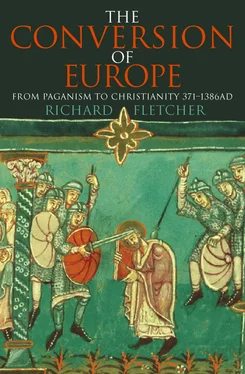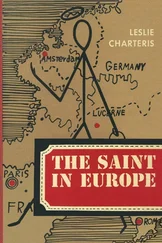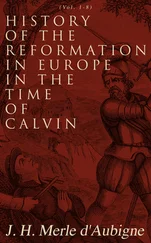Germanic settlement in what had been imperial Roman territory wrought changes in Europe’s linguistic boundaries. The eastern frontier of the empire on the continental mainland had been marked, roughly speaking, by the course of the rivers Rhine and Danube. Within that line the language of everyday speech for many, and of authority for all, had been Latin, the ancestor of the Romance languages of today. The influx of Germanic peoples in the fourth and fifth centuries pushed Latin westwards and southwards and substituted Germanic speech in a swathe of territory within what had once been the imperial frontiers. That is why Austrians and many Swiss speak varieties of German to this day. It need hardly be stressed that the pattern of linguistic change is neither neat nor simple. It therefore affords plentiful opportunity for lively academic debate. Philologists are a combative lot, and scholarly wrangling has been made the fiercer by the nationalistic dementia of the nineteenth and twentieth centuries. Particularly has this been so in relation to the area upon which we must first concentrate attention in this chapter, the valleys of the Rhine and its western tributary the Mosel (or Moselle – which neatly encapsulates the debate). The linguistic frontier was never static. However, as a very rough approximation the map facing page 136 shows the state of affairs in the latter part of the sixth century. It will be seen that Germanic speech was current as far west as Boulogne and as far southwest as Metz and Strasbourg, with outposts further to the west, for example among the Saxon settlers in the Bayeux region and near the mouth of the Loire. And there were enclaves of Latin/Romance further to the east, for example at the city of Trier.
There is every reason to suppose that the fortunes of Christianity had run in tandem with those of its Roman language. We can detect a flourishing urban or suburban Christianity in the late fourth century. Trier, as befitted a city which was then the imperial capital in Gaul, was emphatically Christian. We might recall the community which had so impressed Augustine’s friend Ponticianus (above, p. 27). The sense of burgeoning vitality imparted by that story is confirmed by the archaeological evidence of Christian building activity in Trier – and elsewhere. At Bonn, for example, a Christian church was rebuilt at the end of the fourth century, replacing on a more generous scale an earlier chapel. Matters were different, of course, in the rural hinterland. But there were grounds for optimism. Martin had visited Trier and made an impression upon members of the local elite such as Tetradius. His friend Bishop Victricius of Rouen was making sorties into the pagan countryside of Artois.
Quite suddenly the light was snuffed out. The seat of government was removed from Trier to Arles – with all that this implied for influential concern and wealthy patronage. The Rhine frontier was pierced by the barbarian invasion of the winter of 406–7. Trier was attacked by the Franks four times in thirty-four years. Roman order collapsed, and with it the apparatus of organized Christianity. This is not to say that the faith itself entirely disappeared. It withdrew into little enclaves here and there, where best it could survive under the protection of town walls or powerful men. We know little of its fortunes, for the written sources give out almost as completely as they do in fifth-century Britain: a silence which is itself eloquent. There are gaps in the episcopal lists. At Cologne, for example, no bishop is known between Severinus in about 400 and Carentius, attested in 566. We catch glimpses of Christianity in the occasional Rhineland tombstones, some of them illustrated in plates 11 and 12. The sorrowing parents of the eight-year-old Desideratus could commission a gravestone, at Kobern near Koblenz, inscribed with Latin hexameters and Christian symbols, at some point in the fifth century. Sometimes we can spot the new arrivals embracing the faith of Rome. The parents of Rignetrudis – presumably Frankish, from her name (though this argument is not without its difficulties, as we shall see presently) – erected an elegant Christian tombstone with a Latin inscription to mark the grave of their beloved sixteen-year-old daughter at Brühl-Vochem, a little to the south of Cologne, sometime in the sixth century. But frequently the signals are ambiguous. Consider the Frankish nobleman buried at Morken, between Aachen and Cologne, a likely contemporary and a near neighbour of Rignetrudis. His relatives buried him in a wooden chamber with weapons and whetstone and shield, with jewellery and coin, with vessels of glass and bronze, bit and bridle and bucket, hefty joints of pork and beef. Was he a pagan or a Christian? There is no conclusive evidence either way. And what of the warrior commemorated in the famously enigmatic stone (plates 13 and 14 at Niederdollendorf, a bit further up the Rhine, at some point in the seventh century? What did he believe in? It may be that these are the wrong sort of questions: well, less appropriate than some others. The antithesis pagan/Christian may be too neat and simple. Reality tends to be fuzzy. (It will be a part of the argument of this and the following chapter that fuzziness is an essential and important part of the process of barbarian conversion. But this is to anticipate.) For the moment let us simply observe that grave-goods and uninscribed tombstones are at best ambiguous witnesses to belief.
Gregory of Tours, however, is not. He tells a story of his uncle Gallus (not to be confused with Columbanus’ disciple of the same name), set in Cologne in about the year 530. Gallus had gone there in the company of King Theuderic I, son of Clovis.
There was a temple there filled with various adornments, where the barbarians of the area used to make offerings and gorge themselves with meat and wine until they vomited: they adored idols there as if they were gods, and placed there wooden models of parts of the human body whenever some part of their body was touched by pain. As soon as Gallus learned this he hastened to the place with one other cleric, and having lit a fire he brought it to the temple and set it alight, while none of the foolish pagans was present. They saw the smoke of the temple going up into the sky, and looked for the one who had lit the blaze; they found him and ran after him, their swords in their hands. Gallus took to his heels and hid in the royal palace. The king learned from the threats of the pagans what had happened, and he pacified them with sweet words, calming their impudent anger. The blessed man used to tell this often, adding with tears, ‘Woe is me for not having stood my ground, so that I might have ended my life in this cause.’ 1
The evidence, such as it is, leaves us with a sense that in north-eastern Gaul the Frankish invasions and settlement had obliterated much, though not all, of the Christian culture of the region. An effort of ‘re-Christianization’ was called for. In about 500 or shortly afterwards Bishop Remigius of Rheims sent a man named Vedastus (Vedast, Vaast), a native of Aquitaine who had been living as a hermit near Toul, to become bishop of Arras. His biographer, writing in about 640, tells of how he found his cathedral church overgrown with brambles and defiled by animals, the city deserted since its sack by Attila the Hun: Vedastus had to expel a bear from the town, commanding it never to return. These are hagiographical commonplaces, not to be taken literally. (Attila never went anywhere near Arras but he was a convenient hate-figure to whom acts of destruction could unhesitatingly be attributed.) However, they convey vividly a sense of what the seventh century thought had been going on in the sixth. We know little if anything for certain of what Vedastus might have achieved in the course of his long episcopate at Arras – he died in about 540. It was probably not much. But it was a start.
Читать дальше












